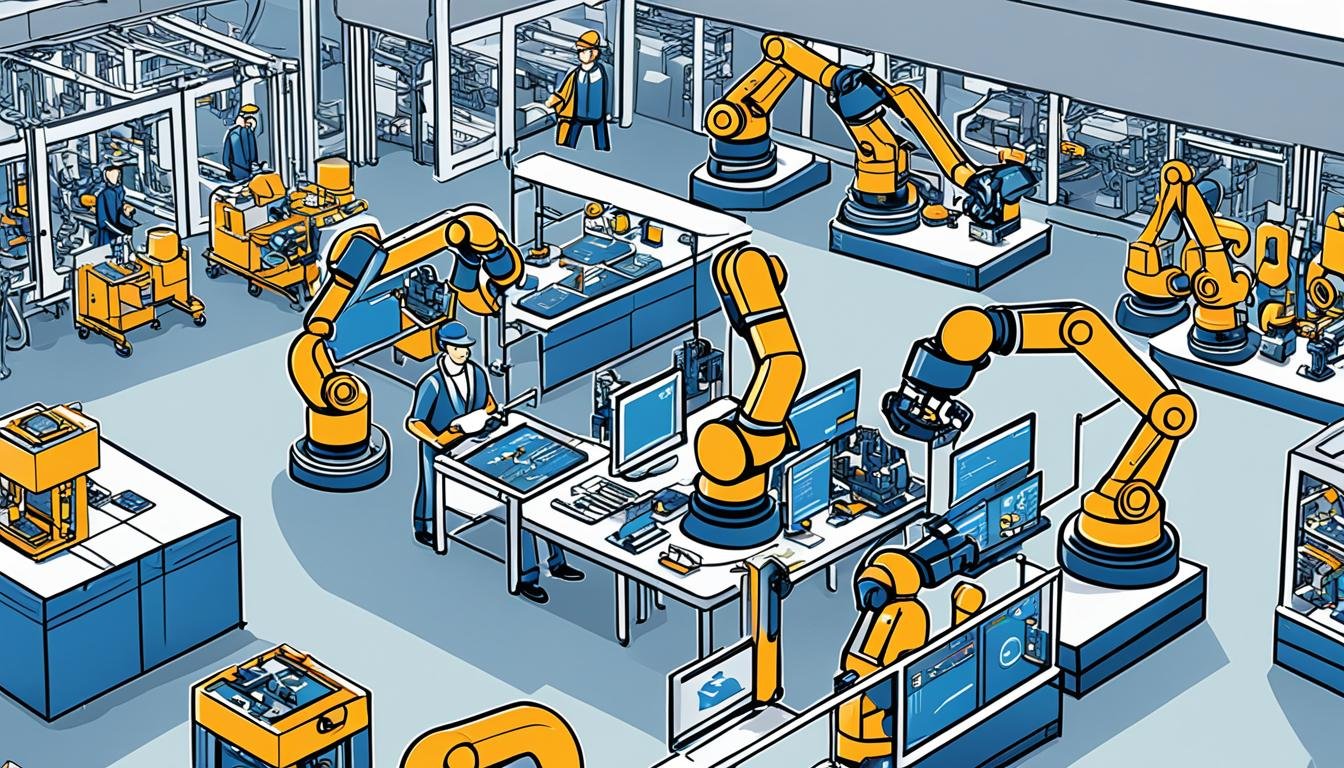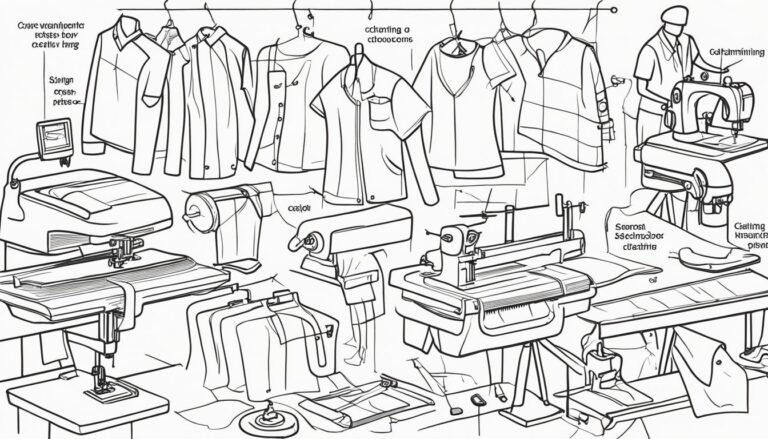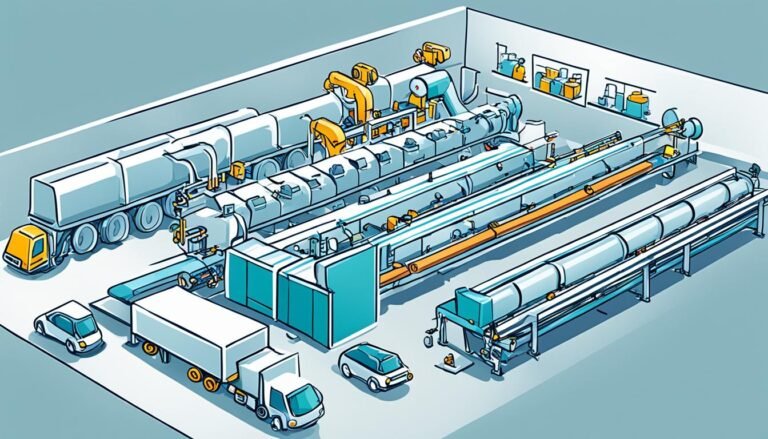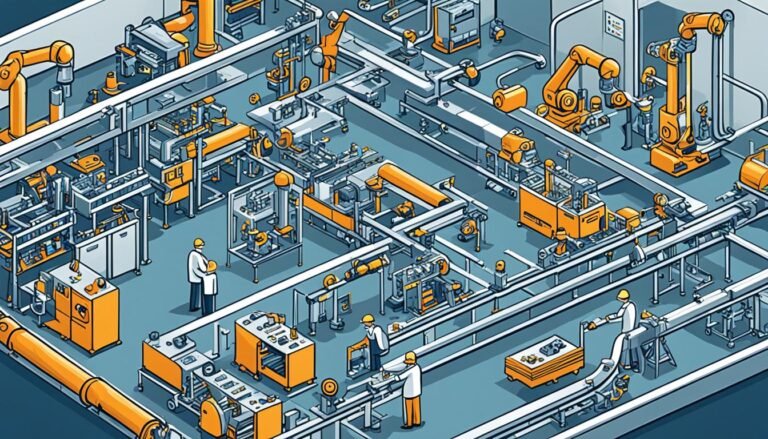Understanding Industry 4.0 and Smart Manufacturing
As of 2021, only 114 members were part of the Global Lighthouse Network. This shows how slowly but surely, advanced technology is being adopted in manufacturing. Industry 4.0, also known as smart manufacturing, is changing how industries work. It uses IoT, cloud computing, big data, AI, and machine learning to make factories smarter.
The journey from steam power in the late 18th century to today’s Industry 4.0 shows our drive for better efficiency and innovation. This fourth industrial revolution focuses on cyber-physical systems and blending advanced tech into manufacturing. It aims to make production better and cut down on waste.
Technologies like IoT, AI, and edge computing are changing how we make things and run businesses. They help with real-time monitoring, better quality control, and clearer supply chains.
Key Takeaways
- Industry 4.0, also known as smart manufacturing, is about making industries digital.
- Key technologies include IoT, cloud computing, AI, machine learning, and edge computing.
- Smart factories use these technologies for more automation and predictive maintenance.
- The goal is to make production better, more precise, and adaptable.
- Cybersecurity is key for smart factories to work well.
Introduction to Industry 4.0
Industry 4.0 is changing how we make things and work. It combines physical and digital technologies. This era brings together IoT, big data, and cyber-physical systems to change old ways.
This change is not just an update. It’s a big shift in how factories work, design, and meet customer needs.
The Birth of Industry 4.0
At the Hannover MESSE in 2011, Industry 4.0 was first talked about. It aimed to change manufacturing and start the Fourth Industrial Revolution. The name Industry 4.0 shows how new digital tech boosts automation and connects the physical and digital worlds.
The German government started this with the “High-Tech Strategy 2020” in 2012. Other countries like China and the U.S. also joined in. China’s “Made in China 2025” and the U.S.’s “Manufacturing USA” aimed to improve production.
First to Fourth Industrial Revolutions
The path to Industry 4.0 goes back to three big changes:
- First Industrial Revolution: Started with machines using water and steam power, making mass production possible.
- Second Industrial Revolution: Brought in electricity, making factories more efficient and big.
- Third Industrial Revolution: Added computers, automating more and making things more precise.
Now, Industry 4.0 uses digital tech to link the physical and cyber worlds. It brings new things like IoT, big data, AI, and robotics.
Key Drivers Behind Industry 4.0
Several things are pushing Industry 4.0 forward:
- Efficiency and Productivity: Digital and automation make things more efficient and productive. For example, a coffee machine plant in Treviso, Italy, saw a 33% increase in productivity.
- Adaptability: Cyber-physical systems help companies quickly adapt to new market trends and customer needs.
- Sustainability: Industry 4.0 uses resources better, making things more sustainable and reducing harm to the environment.
- Future-Proofing: Trying out new tech and investing is key to staying ahead. In 2019, 68% of companies saw Industry 4.0 as a top priority, with 70% testing or using new tech.
The COVID-19 pandemic showed how important Industry 4.0 is. McKinsey found that 94% of companies said these tech helped them keep running during the crisis. This highlights how digital tech is crucial for keeping businesses going.
The following table presents some key statistics:
| Statistic | Insight |
|---|---|
| Introduction Year | 2011 at Hannover MESSE |
| Strategic Priority | 68% consider Industry 4.0 a top priority |
| Deployment Rate | 70% piloting or utilizing new technologies |
| Impact of COVID-19 | 94% confirmed Industry 4.0 helped maintain operations during the pandemic |
| Productivity Gain | 33% surge in labor productivity in Treviso plant |
| Cost Savings | Potential of up to 40% by integrating Lean and Industry 4.0 |
Key Components of Industry 4.0
Industry 4.0 technologies are changing how we make things. They bring together several key parts to make systems smart and connected. Let’s look closer at these important elements.
Cyber-Physical Systems (CPS)
Cyber-Physical Systems (CPS) link machines with sensors and software over networks. This lets different parts talk to each other and to people. It makes it possible to watch and control things in real time, which is key for making things with data.
For example, Schneider Electric uses CPS in its Kentucky factory. It helps automate production and cuts down on mistakes.
Internet of Things (IoT)
The Internet of Things (IoT) is crucial in Industry 4.0. It connects devices and systems for better data sharing. This flow of information makes manufacturing more precise and efficient.
When combined with CPS, IoT helps use big data and analytics better. This leads to smarter and more efficient ways of making things.
Big Data and Analytics
Big data and analytics are vital for understanding trends and predicting problems like equipment failure. They turn lots of data into useful insights. In 2020, about three-quarters of companies using Industry 4.0 were struggling to make the most of it, says McKinsey.
Using lots of data analytics is key to getting a good return on investment and boosting efficiency.
Artificial Intelligence (AI) and Machine Learning (ML)
Artificial intelligence (AI) and machine learning (ML) are leading the smart manufacturing change. They look at data to make production better, reduce waste, and speed up delivery. AI helps predict when equipment might break, which cuts down on downtime and boosts productivity.
Cloud and Edge Computing
Cloud and edge computing are key for Industry 4.0. They offer storage and processing power on a large scale, allowing for quick data analysis where it’s needed. Companies are working together to improve applications, databases, and AI services for manufacturers.
Edge computing lets data be processed closer to where it’s needed. This supports fast decision-making and makes production more efficient.
| Component | Function | Impact |
|---|---|---|
| CPS | Integrates machinery with networked sensors | Enables real-time monitoring and control |
| IoT Integration | Interconnects devices and systems | Facilitates superior data exchange |
| Big Data and Analytics | Analyzes large datasets | Transforms data into actionable intelligence |
| AI and ML | Optimizes production processes | Reduces material loss, improves delivery times |
| Cloud and Edge Computing | Provides scalable storage and processing | Enables real-time analysis and decision-making |
These Industry 4.0 technologies are taking the manufacturing world to new heights. By using CPS, IoT, data-driven manufacturing, AI, and edge computing, manufacturers can greatly improve their work. They can achieve new levels of efficiency and productivity.
What is Smart Manufacturing?
Smart manufacturing is changing how businesses make things by using new technologies. It’s all about making things better by using data and adapting to change. It focuses on making the manufacturing process better, not just any industry.
Core Principles
Smart manufacturing has key ideas that make it work well:
- Interconnectedness: Machines talk to each other using IoT for smooth operations.
- Data-Driven Decision-Making: Using data and analytics to make smart choices in production.
- Adaptability: Making quick changes to meet new market needs.
- Visibility: Using digital tools to see and manage every step of production.
Benefits of Smart Manufacturing
Smart manufacturing has big advantages:
- Improved Productivity: Automation and AI make things run smoother and faster.
- Better Quality Control: Watching and predicting problems means fewer mistakes and better products.
- Cost Reduction: Predictive maintenance and IoT cut down on downtime and save money.
- Flexibility: Digital tools let production change easily to meet different customer needs.
By using IoT, digital manufacturing, and AI, smart manufacturing is set to keep changing the industry. It’s making things more efficient, reliable, and able to adapt.
Understanding Industry 4.0 and Smart Manufacturing
The world is moving into the Industry 4.0 advancements era. Here, smart manufacturing and new technologies work together. The Industrial Internet of Things (IIoT) and robotics are key in making processes automatic. They improve quality and make things more efficient.
This mix leads to a production model that can quickly adapt. It also meets the need for more customized products. This marks the start of a big change in how things are made.
Using Cloud Computing is a big part of this change. It helps connect different parts of a business smoothly. With better data analysis, companies can make smarter choices and run better.
They can also use predictive maintenance with machine learning. This cuts down on machine downtime by up to 50%. It also makes machines last 20-40% longer.
Switching to smart factories brings clear benefits. Here are some examples:
- General Electric (GE) cut defect rates by up to 25% with AI-driven inspection systems.
- Ford used wearable tech to lower injury risks by 70% for workers on the assembly line.
- Harley-Davidson sped up their build-to-order process from 21 days to just 6 hours with IoT and advanced analytics.
- ABB cut energy use by 50% and boosted efficiency by 25% in its Helsinki factory with digital twins and AI analytics.
These stories show how Industry 4.0 tech leads to more productivity and cost savings. By embracing these changes, companies can improve their production and lead in innovation worldwide.
Real-World Applications and Case Studies
Industry 4.0 and Smart Manufacturing have changed many sectors with new technologies. This section looks at key areas where these changes are big news.
Smart Factories
Smart factories show how digital tech leads to modernization. They use ERP, IoT, IIoT, and Big Data Analytics for better decision-making. For example, General Electric uses AWS data analytics to make power plants more efficient.
Predictive Maintenance
Predictive maintenance software helps companies fix problems before they get worse. It uses IoT data to predict and prevent issues. The IMC Solution by AWS is a great example of how to connect machines for predictive maintenance.
Quality Control and Real-time Monitoring
AI quality control systems are key for keeping products top-notch. Real-time monitoring cuts down on waste and fixes quality problems right away. IoT and IIoT sensors help analyze trends for better quality control.
Supply Chain Integration
Supply chain tech makes logistics smoother and more efficient. It brings more transparency and quick responses, boosting productivity and adaptability. Tools for managing supply chains and tracking assets show how connected systems improve workflows.
Conclusion
The era of Industry 4.0 and smart manufacturing is changing the game. It brings new levels of efficiency and speed to businesses. By using the IoT and automation, companies can transform their future.
Studies show that IoT can cut equipment breakdowns by over 69%. This means maintenance costs go down by more than 24%. Also, watching production lines in real-time can save energy costs by 40% or more.
This shows how crucial smart manufacturing is for today’s businesses. It helps avoid costly machine failures, which can cost up to USD 250,000 an hour. This adds up to nearly USD 50 billion a year.
The global Smart Manufacturing market is expected to hit $573.8 billion by 2027. Automation and digitization play a big part in this growth. They help reduce errors by more than 65%.
Most manufacturers see a boost in efficiency and productivity, with 87% reporting positive results. Quality also improves for 80% of them. Smart technologies are set to change the manufacturing world, creating 2.3 million new jobs by 2025.
For companies, staying on top in this digital shift is key. Investing in smart manufacturing tech boosts their skills and keeps them competitive in a fast-changing world.
Source Links
- What is Industry 4.0 and how does it work? | IBM
- How does a smart factory differ from smart manufacturing…and why does that matter?
- Industry 4.0: Smart Manufacturing Explained
- What are Industry 4.0, the Fourth Industrial Revolution, and 4IR?
- PROCESSA | Smart manufacturing or Industry 4.0 – explained
- Industry 4.0 and Smart Manufacturing
- 10 Core Components of Industry 4.0
- Smart Manufacturing and Industry 4.0: The Future of Manufacturing
- Industry 4.0 – Reviewing The Future of Manufacturing – Metrology and Quality News – Online Magazine
- A beginner’s guide to understanding industry 4.0
- Understanding Industry 4.0: The Fourth Industrial Revolution
- How Industry 4.0 is Transforming Manufacturing | Reliability and Maintainability Center
- Industry 4.0 and Smart Factory an Outlook
- Industry 4.0 Manufacturing: 8 Real-World Examples & Benefits
- Industry 4.0 and Smart Manufacturing on the PCB Manufacturing Industry
- Industry 4.0 and the Benefits of Smart Manufacturing







